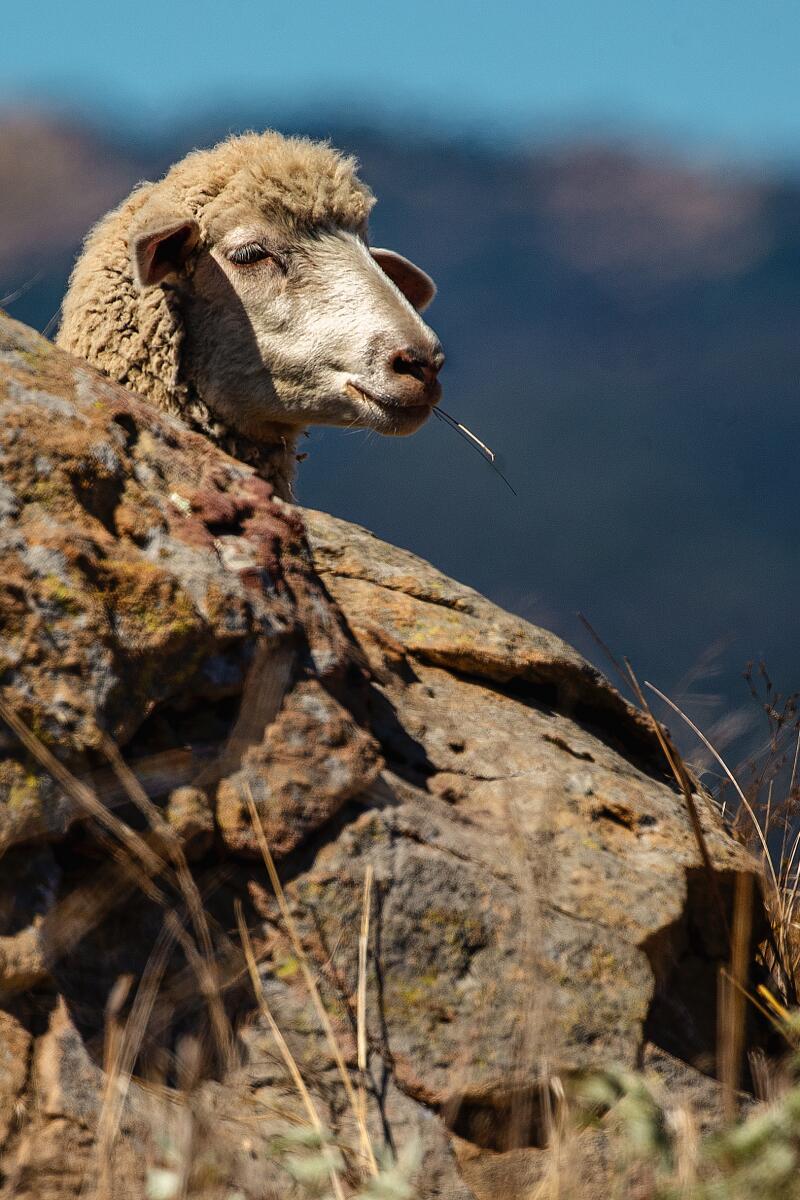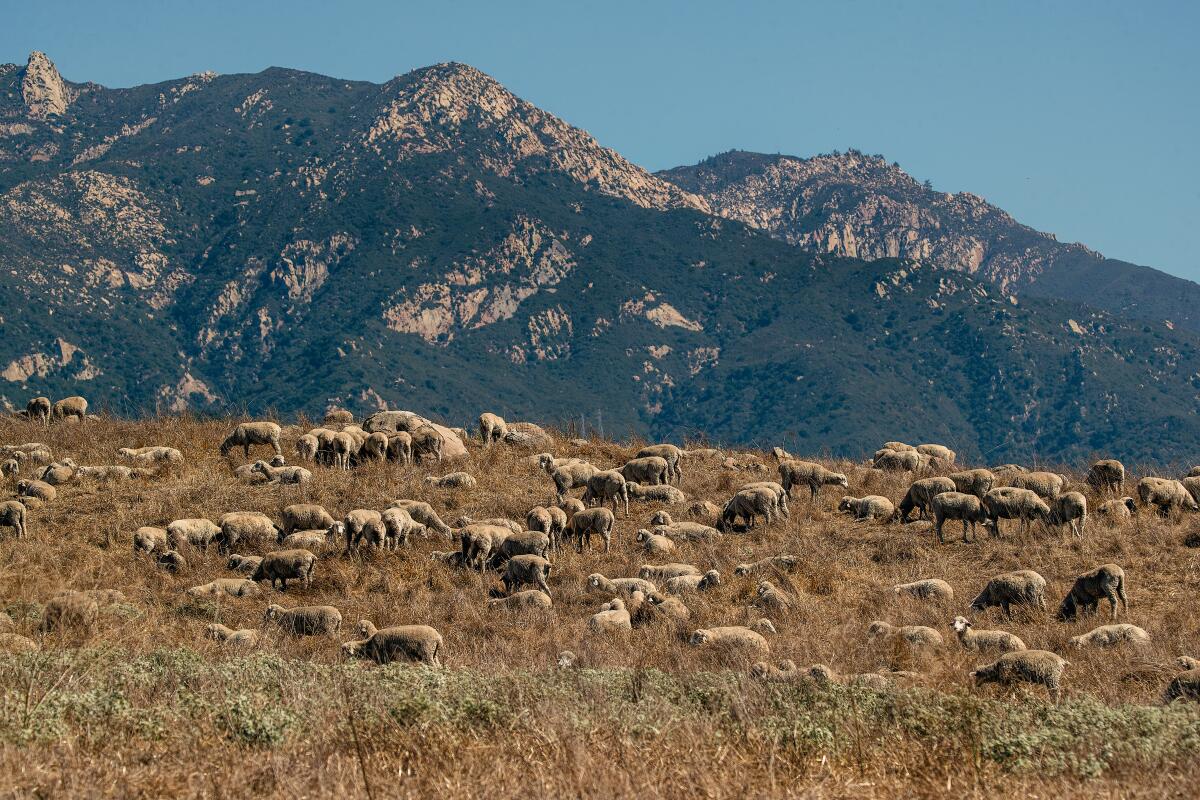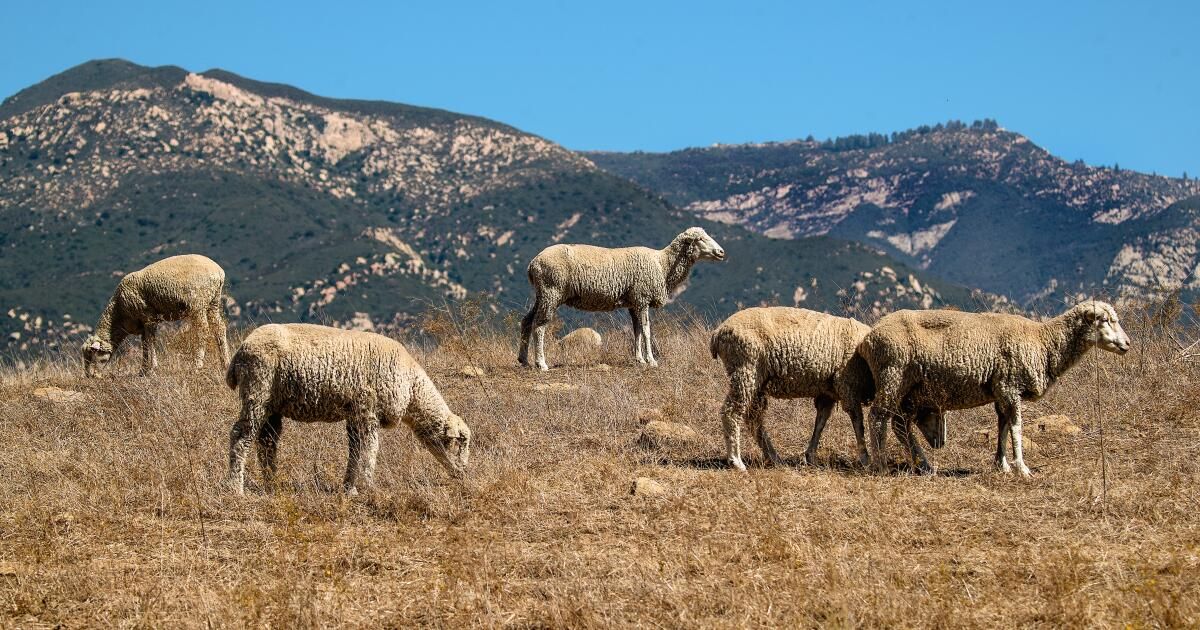On one side of a trail in the idyllic hills of Santa Barbara, a dense clump of dried mustard rises more than seven feet. Meanwhile, on the other side of the road, the invasive plant is reduced to tufts.
Carolyn Chaney, 77, pointed out the difference in vegetation and also gave the reason: the sheep.
“This is where they've been,” he said, pointing to the cleared ground.
Chaney would know. She is a regular sheep guide on the 300-acre San Marcos Foothills Reservation, owned by Santa Barbara County and located between Santa Barbara and Goleta.
Docent Carolyn Chaney, 77, stands next to non-native mustard growing within the San Marcos Foothills Preserve in Santa Barbara.
(Mel Melcón / Los Angeles Times)
Ken Owen, executive director of Channel Islands Restoration, a nonprofit that manages the reserve, said his team came up with the concept for the specialized docent.
“I don't know any other sheep teachers anywhere in the world,” he said.
The docents are volunteers who essentially hang out at the reserve to say hello and explain why there are hundreds of even ungulates eating the grass. They are provided with an information packet about the grazing project so they can answer questions that curious hikers may ask.
For those who can't make the hike and call a guide: sheep are brought to help restore native grasslands by devouring virulent invaders like mustard, according to Channel Islands Restoration.


A few hundred sheep, like this one, were trucked in to munch on invasive plants, allowing native ones to thrive within the San Marcos Foothills Preserve in Santa Barbara. (Mel Melcón / Los Angeles Times) Docent Carolyn Chaney, 77, crouches next to native plants, tar, left, and turkey mullein, that grow within the San Marcos Foothills Preserve in Santa Barbara. (Mel Melcón / Los Angeles Times)
In spring 2019, the reserve began supervised grazing with the goal of providing habitat for native birds, many of which are rare or completely absent. That November, the Cave Fire started in the Santa Ynez Mountains and raged into southern neighborhoods. When the fire reached the reservation, a curious thing happened: it stopped, allowing firefighters to put it out.
“So it has the incredible side effect of being able to save neighborhoods,” Owen said.
The firefighters agreed and the Santa Barbara County Fire Safety Council is financially supporting the current grazing cycle through a grant.
“It was obvious that the fire protection provided by the grazing area was the primary factor in reducing the rate of spread and intensity of the fire, allowing firefighters to aggressively extinguish the fire,” wrote Rob Hazard, division chief of the Santa Barbara County Fire Department. in a 2022 letter to Owen.
Despite the perceived benefits, grazing remains controversial.
Naturalist John Muir described sheep as “hoofed lobsters” for their ability to despoil the landscape. You don't have to look far to find a case study: a grim one lies about 30 miles off the coast of Ventura in the Channel Islands. Sheep arrived on the islands in the 19th century and chewed and trampled the land to destruction (with the help of other livestock activities).

Hundreds of Merino sheep graze in the West Mesa area of the San Marcos Foothills Reserve.
(Mel Melcón / Los Angeles Times)
However, Owen said that when grazing is controlled (meaning livestock are closely monitored and moved frequently) the sheep not only don't damage the landscape, they actually improve it.
Owen said he recently had a heated two-and-a-half-hour conversation with a skeptic: “She said, 'You have no idea what they're eating there.' You don't have the slightest idea. She kept telling me that over and over. It took me about an hour to calm her down and… say, 'Oh yeah, we do.'”
Getting woolly ruminants to eat the right plants comes down to timing, said Jack Anderson, co-owner and operator of Cuyama Lamb, which provides grazing services.
Livestock are typically trucked in twice a year, he said. First, they arrive early in the growing season, when moisture can cause invasive Mediterranean annuals to grow rapidly. The native ones, often perennials, take longer to get going.
Reducing invasive competition provides natives with the sunlight they need to germinate.
“Right now, that's what's happening,” Anderson said.
A second pass occurs in the last dry season to remove what is known as thatch from the soil.

Docent Carolyn Chaney walks past turkey mullein, foreground, a native plant that grows in the San Marcos Foothills Preserve in Santa Barbara.
(Mel Melcón / Los Angeles Times)
Sheep currently graze in the West Mesa Reservation area, which in 2021 community stakeholders banded together to purchase from developers. The campaign raised $18.6 million to purchase the 101-acre site sacred to the Chumash tribe.
Since the program began (which, ecologically speaking, is a short period of time), the percentage of native plants has increased, Anderson said.
Ground-nesting birds, such as the tiny grasshopper sparrow, are more elusive. On May 12, 2001, in terms of sparrows, there were 25 singing males, three pairs, four “visuals” and two flying individuals in the reserve, according to the Channel Islands Restoration website. The birds have since disappeared, which is believed to be related to the removal of grazing livestock.
There is no concerted effort to reintroduce sparrows or other birds, Owen said, but grazing creates a landscape more conducive to their nesting, foraging and other activities.
Land management is an ongoing effort, according to Anderson.
“We've been a little bit wrong in the way we've been thinking about ecological management, which is that we want to get to a point where it now, in some way, takes care of itself naturally,” Anderson said, ” “And that's a condition that has never existed in California. Native Americans were constantly managing their environment on a large scale.” That included burning vegetation, bringing in animals at certain times, and tending trees.

Docent Debra Fedaleo photographs one of the few hundred sheep at the San Marcos Foothills Preserve.
(Mel Melcón / Los Angeles Times)
Teachers can allay concerns about sheep by explaining that herding is done methodically, Owen said. No experience required; Those interested can sign up online for a 2 hour and 50 minute shift. Spaces are available until November 6 at 9 a.m., 11:30 a.m. and 2 p.m.
Most people are thrilled to see the animals, Owen said.
On a warm afternoon in early October, a short hike along a trail in the West Mesa area of the reservation provided a pastoral panorama. Around 340 sheep from the Merino family, whose wool is often used to make sweaters and socks, grazed contentedly on dry, yellow grass. Green oak trees dotted the otherwise dry landscape as the Pacific Ocean shimmered below.
A large white dog, a Great Pyrenees and Kangal shepherd mix, was resting near watering holes along with her two grandchildren. (As a guard dog, it wouldn't be her time to shine until later in the evening, when predators like coyotes begin to emerge.)
The sheep did not utter a single “bah”. Instead, if you listened closely, you could hear the crunching of hundreds of mouths hard at work.












